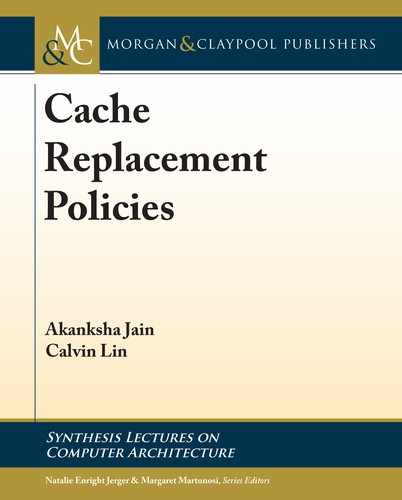5.6. NEW TECHNOLOGY CONSIDERATIONS 55
the resulting compressed cache loses the performance gains from state-of-the-art replacement
policies.
To avoid negative interactions with replacement policies, Gaur et al. introduce a cache de-
sign that guarantees that all lines that would have existed in an uncompressed cache would also
be present in the compressed cache. In particular, their cache design keeps the data array unmod-
ified, but it modifies the tag array to accommodate compression. In particular, the tag array is
augmented to associate two tags with each physical way. Logically, the cache is partitioned into
a Baseline cache, which is managed just like an uncompressed cache, and a Victim cache, which
opportunistically caches victims from the baseline cache if they can be compressed. is design
guarantees a hit rate at least as high as that of an uncompressed cache, so it enjoys the benefits
of advanced replacement policies. Furthermore, it can leverage the benefits of compression with
simple modifications to the tag array.
5.6 NEW TECHNOLOGY CONSIDERATIONS
For many decades now, caches have been built using SRAM technology, but newer memory
technologies promise change as they have been shown to address many limitations of conven-
tional SRAM caches [Fujita et al., 2017, Wong et al., 2016]. An in-depth analysis of these
technologies is beyond the scope of this book, but we now briefly discuss design tradeoffs that
emerging memory technologies will introduce for cache replacement.
5.6.1 NVM CACHES
Korgaonkar et al. show that last-level caches based on Non-Volatile Memories (NVM) promise
high capacity and low power but suffer from performance degradation due to their high write
latency [Korgaonkar et al., 2018]. In particular, the high latency of writes puts pressure on
the NVM cache’s request queues, which puts backpressure on the CPU and interferes with
performance-critical read requests.
To mitigate these issues, Korgaonkar et al. propose two cache replacement strategies. First,
they introduce a write congestion aware bypass (WCAB) policy that eliminates a large fraction
of writes to the NVM cache, while avoiding large reductions in the cache’s hit rate. Second,
they establish a virtual hybrid cache that absorbs and eliminates redundant writes that would
otherwise result in slow NVM writes.
WCAB builds on the observation that traditional bypassing policies [Khan et al., 2010]
perform a limited number of write bypasses because they optimize for hit rates instead of write
intensity. Unfortunately, naively increasing the intensity of write bypassing adversely affects the
cache’s hit rate, negating the capacity benefits of NVM caches. us, we have a tradeoff be-
tween cache hit rate and write intensity. Korgaonkar et al. manage this tradeoff by dynamically
estimating write congestion and liveness. If write congestion is high, WCAB sets a high target
live score, which means that the liveness score of a line would have to be extremely high for it
not to be bypassed. Alternatively, if the write congestion is low, WCAB performs conservative
..................Content has been hidden....................
You can't read the all page of ebook, please click here login for view all page.
